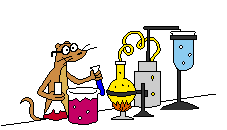Names and Formulas
Exercises
Practice Problems
Name the following compounds:
1. NaNO3
2. KI
3. BaCl2
4. PCl3
5. ZnSO4
6. Al2O3
7. CaCO3
8. (NH4)3PO4
9. H2SO4 (acid name)
10. CuCl2
11. CsBr
12. Fe(ClO4)3
13. H2S (molecular name)
14. H2S (acid name)
15. Na2CrO4
16. FeS
17. P4O10
18. HC2H3O2 or CH3COOH (acid name)
19. CuNO2
20. HClO3 (acid name)
21. CrF3
22. NaCN
23. NiSO3
24. H3PO4 (acid name)
25. AgNO3
26. Mg3N2
27. K2Cr2O7
28. AuBr3
29. (NH4)C2H3O2
30. HgO
31. HBrO4 (acid name)
32. Na2SeO4
33. CdS
34. MnO2
35. Hg2Cl2
36. Sr3(PO3)2
37. HClO (acid name)
38. HNO2 (acid name)
39. WCl5
40. SnBr2
41. PbCl4
42. TiO2
43. XeF4
44. KMnO4
45. HIO4 (acid name)
46. HBr (molecular name)
47. HBr (acid name)
48. SF6
49. LiHCO3
50. SiCl4
Write the formula of the following compounds:
51. sulfur trioxide
52. oxygen (as found in our atmosphere)
53. sodium chlorite
54. iron(II) nitrate
55. potassium hydroxide
56. lithium sulfite
57. arsenic acid
58. antimony(III) bromide or antimony tribromide
59. oxygen difluoride
60. hydroiodic acid
61. copper(II) arsenide or cupric arsenide
62. zinc hydroxide
63. hydrogen peroxide
64. ammonium sulfide
65. cobalt(III) iodide or cobaltic iodide
66. iron(III) phosphate or ferric phosphate
67. hydrocyanic acid
68. calcium hypochlorite
69. sodium dihydrogenphosphate
70. carbon monoxide
71. hydrogen (in its normal state)
72. nickel(II) chloride hexahydrate
73. aluminum sulfate
74. tin(IV) bromide or stannic bromide
75. sodium hypophosphite
76. magnesium selenate
77. sodium hydride
78. chromium(II) oxalate or chromous oxalate
79. sulfurous acid
80. dinitrogen tetroxide
81. manganese(II) acetate
82. sodium hydrosulfide
83. gallium(III) bromide
84. nitric acid
85. methane
86. ammonia
87. boron nitride
88. silver carbonate
89. aluminum sulfide
90. lead(IV) oxide or plumbic oxide
91. iodine (in its normal state)
92. sulfur (in its normal state)
93. barium chromate
94. perchloric acid
95. bromine trifluoride
96. helium
97. copper(I) acetate or cuprous acetate
98. vanadium(III) bromide
99. osmium(II) sulfite
100. selenious acid
Answers
1. sodium nitrate
2. potassium iodide
3. barium chloride
4. phosphorus trichloride
5. zinc sulfate
6. aluminum oxide
7. calcium carbonate
8. ammonium phosphate
9. sulfuric acid
10. copper(II) chloride or cupric chloride
11. cesium bromide
12. iron(III) perchlorate or ferric perchlorate
13. dihydrogen sulfide (or simply hydrogen sulfide)
14. hydrosulfuric acid
15. sodium chromate
16. iron(II) sulfide or ferrous sulfide
17. tetraphosphorus decoxide
18. acetic acid (or ethanoic acid)
19. copper(I) nitrite or cuprous nitrite
20. chloric acid
21. chromium(III) fluoride or chromic fluoride
22. sodium cyanide
23. nickel(II) sulfite or nickelous sulfite or simply nickel sulfite
24. phosphoric acid
25. silver nitrate
26. magnesium nitride
27. potassium dichromate
28. gold(III) bromide or auric bromide
29. ammonium acetate
30. mercury(II) oxide or mercuric oxide
31. perbromic acid
32. sodium selenate
33. cadmium sulfide
34. manganese(IV) oxide (usually called manganese dioxide)
35. mercury(I) chloride or mercurous chloride
36. strontium phosphite
37. hypochlorous acid
38. nitrous acid
39. tungsten(V) chloride (also called tungsten pentachloride)
40. tin(II) bromide or stannous bromide
41. lead(IV) chloride or plumbic chloride
42. titanium(IV) oxide (commonly called titanium dioxide)
43. xenon tetrafluoride
44. potassium permanganate
45. periodic acid
46. hydrogen bromide
47. hydrobromic acid
48. sulfur hexafluoride
49. lithium hydrogencarbonate or lithium bicarbonate
50. silicon tetrachloride
51. SO3
52. O2 (also called dioxygen)
53. NaClO2
54. Fe(NO3)2
55. KOH
56. Li2SO3
57. H3AsO4 (compare to phosphoric acid)
58. SbBr3
59. OF2
60. HI
61. Cu3As2
62. Zn(OH)2
63. H2O2
64. (NH4)2S
65. CoI3
66. FePO4
67. HCN
68. Ca(ClO)2
69. NaH2PO4
70. CO
71. H2
72. NiCl2 �?6 H2O
73. Al2(SO4)3
74. SnBr4
75. Na3PO2
76. MgSeO4 (compare to magnesium sulfate)
77. NaH
78. CrC2O4
79. H2SO3
80. N2O4
81. Mn(C2H3O2)2
82. NaHS
83. GaBr3
84. HNO3
85. CH4
86. NH3
87. BN
88. Ag2CO3
89. Al2S3
90. PbO2
91. I2
92. S8
93. BaCrO4
94. HClO4
95. BrF3
96. He
97. CuC2H3O2
98. VBr3
99. OsSO3
100. H2SeO3 (compare to sulfurous acid)

 Free Forum Hosting
Free Forum Hosting